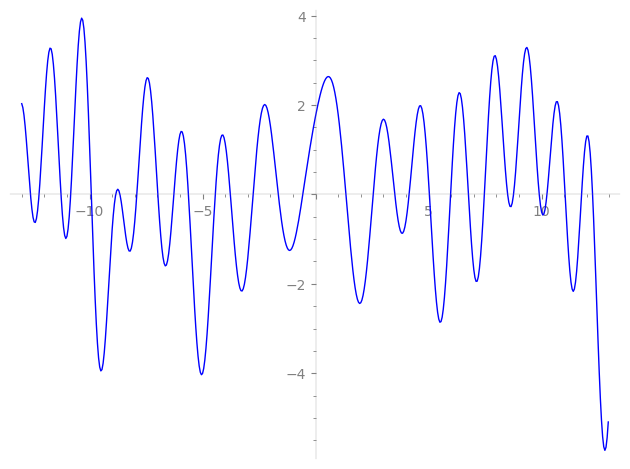| L(s) = 1 | + (0.5 − 0.866i)3-s + (−0.5 − 0.866i)5-s + (−0.499 − 0.866i)9-s + (1 − 1.73i)11-s + 4·13-s − 0.999·15-s + (−1 + 1.73i)17-s + (−1 − 1.73i)19-s + (−2 − 3.46i)23-s + (−0.499 + 0.866i)25-s − 0.999·27-s + 6·29-s + (1 − 1.73i)31-s + (−0.999 − 1.73i)33-s + (−5 − 8.66i)37-s + ⋯ |
| L(s) = 1 | + (0.288 − 0.499i)3-s + (−0.223 − 0.387i)5-s + (−0.166 − 0.288i)9-s + (0.301 − 0.522i)11-s + 1.10·13-s − 0.258·15-s + (−0.242 + 0.420i)17-s + (−0.229 − 0.397i)19-s + (−0.417 − 0.722i)23-s + (−0.0999 + 0.173i)25-s − 0.192·27-s + 1.11·29-s + (0.179 − 0.311i)31-s + (−0.174 − 0.301i)33-s + (−0.821 − 1.42i)37-s + ⋯ |
Λ(s)=(=(2940s/2ΓC(s)L(s)(−0.386+0.922i)Λ(2−s)
Λ(s)=(=(2940s/2ΓC(s+1/2)L(s)(−0.386+0.922i)Λ(1−s)
| Degree: |
2 |
| Conductor: |
2940
= 22⋅3⋅5⋅72
|
| Sign: |
−0.386+0.922i
|
| Analytic conductor: |
23.4760 |
| Root analytic conductor: |
4.84520 |
| Motivic weight: |
1 |
| Rational: |
no |
| Arithmetic: |
yes |
| Character: |
χ2940(361,⋅)
|
| Primitive: |
yes
|
| Self-dual: |
no
|
| Analytic rank: |
0
|
| Selberg data: |
(2, 2940, ( :1/2), −0.386+0.922i)
|
Particular Values
| L(1) |
≈ |
1.754155203 |
| L(21) |
≈ |
1.754155203 |
| L(23) |
|
not available |
| L(1) |
|
not available |
L(s)=p∏Fp(p−s)−1 | p | Fp(T) |
|---|
| bad | 2 | 1 |
| 3 | 1+(−0.5+0.866i)T |
| 5 | 1+(0.5+0.866i)T |
| 7 | 1 |
| good | 11 | 1+(−1+1.73i)T+(−5.5−9.52i)T2 |
| 13 | 1−4T+13T2 |
| 17 | 1+(1−1.73i)T+(−8.5−14.7i)T2 |
| 19 | 1+(1+1.73i)T+(−9.5+16.4i)T2 |
| 23 | 1+(2+3.46i)T+(−11.5+19.9i)T2 |
| 29 | 1−6T+29T2 |
| 31 | 1+(−1+1.73i)T+(−15.5−26.8i)T2 |
| 37 | 1+(5+8.66i)T+(−18.5+32.0i)T2 |
| 41 | 1+10T+41T2 |
| 43 | 1−12T+43T2 |
| 47 | 1+(−4−6.92i)T+(−23.5+40.7i)T2 |
| 53 | 1+(−26.5−45.8i)T2 |
| 59 | 1+(−4+6.92i)T+(−29.5−51.0i)T2 |
| 61 | 1+(−1−1.73i)T+(−30.5+52.8i)T2 |
| 67 | 1+(−6+10.3i)T+(−33.5−58.0i)T2 |
| 71 | 1+10T+71T2 |
| 73 | 1+(2−3.46i)T+(−36.5−63.2i)T2 |
| 79 | 1+(−39.5+68.4i)T2 |
| 83 | 1+12T+83T2 |
| 89 | 1+(1+1.73i)T+(−44.5+77.0i)T2 |
| 97 | 1+8T+97T2 |
| show more | |
| show less | |
L(s)=p∏ j=1∏2(1−αj,pp−s)−1
Imaginary part of the first few zeros on the critical line
−8.655939034338345697155057699080, −7.907874656403813234861817784412, −6.97809132272929596079752408086, −6.26956590935373123519379768342, −5.62487466143993170523326065425, −4.43729587426430170656510290499, −3.77010574966112410097961211953, −2.76406401030701506625382780557, −1.64937687243616779230932029827, −0.56477112115496538302130946808,
1.34330332175008026168851722396, 2.54854771601251225415914081737, 3.50575859436075359254156725618, 4.13878536680193821875103740551, 5.03653109322354569477218550042, 5.97367861583938014292527882200, 6.76327145842183402637119278082, 7.46768965765711649883025369133, 8.498390417704503515117102502873, 8.757794150409406497292650805055

